Illustrious Snakes
Illustrious Snakes
Introduction
If you find Snakes as mysterious as I do, you will love this post on these sensational creatures.
What are snakes?
Snakes are reptiles, which means they belong to a group of animals that have scales on their bodies and lay eggs on land.
Where are snakes found?
Because snakes are reptiles, they are cold-blooded, which means they can't make their own body heat, therefore, many of them live in warmer areas. Reptiles are ectothermic, meaning they use ambient heat to regulate their body temperature.
Different kinds of snakes slither around in places like forests, deserts, prairies and even in the water.
There are over 3,000 species of snakes in the world, and they live on every continent except in Antarctica, New Zealand, Greenland, Iceland and Ireland.
Classification/Taxonomy
• Scientific name: Serpentes
• Lifespan: Acrochordus arafurae: 9 years
• Higher classification: Ophidia
• Order: Squamata
• Phylum: Chordata
• Diet: Carnivore
Anatomy of a snake:
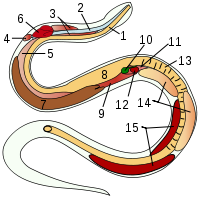
Anatomy 1. esophagus 2. trachea 3. tracheal lungs 4. rudimentary left lung 5. right lung 6. heart 7. liver 8. stomach 9. air sac 10. gallbladder 11. pancreas 12. spleen 13. intestine 14. testicles 15. kidneys
Diet
Snakes are carnivores (zoophagous), which means that they only eat meat.
Snakes feed on birds, eggs, rats, chipmunks, other snakes, deer, and pigs, swallowing them whole. However this is determined on the kind and size of snake, and where they dwell.
Snakes don't have the right kind of teeth to chew, but they can open their mouth very wide and their teeth that point backwards which enables them to grip their prey, holding it firmly and inwards.
Small Snakes
The world's smallest snakes live on a diet of insects and insect eggs. Small snakes may eat small mammals, like mice, rats, or rabbits. They also eat birds and bird eggs. Snakes can also eat other snakes, reptiles like lizards, or amphibians like frogs. Snakes that live in or near water may eat fish.
Large Snakes
Larger snakes are able to eat much larger prey. For example, reticulated pythons and anacondas, which are some of the longest and largest snakes in the world, are known to eat dogs and full grown pigs, and may even grow large enough to eat a human being. Large snakes have also been seen eating other large mammals, such as deer.
Behaviour
Snakes use their forked tongue to smell the air. This enables them to communicate their readiness for mating and to detect prey.
They must shed their skin three to six times per year.
They hibernate during the winter.
Snake Life Cycle
After mating with a male snake, female snakes have baby snakes, called snakelets or hatchlings, in one of three ways, depending on the kind of snake:
- The female snake lays rubbery eggs with snakelets inside that hatch when they are big enough.
- The female snake holds the eggs inside her body until the snakelets hatch and come out.
- The female snake gives birth to live snakelets.
With the exception of certain python species, eggs and young are not cared for by the male or female.
The snakelets continue to grow as they get older, and has to therefore peel its skin off when it gets too tight. The skin comes off, head first, as the snake wriggles out of it and leaves it behind.
Eventually, the snake becomes an adult, and is ready to mate and continues the life cycle process, to create more snakelets.
Symbols

The reverse side of the throne of Pharaoh Tutankhamun with four golden uraeus cobra figures. Gold with lapis lazuli; Valley of the Kings, Thebes (1347–37 BCE).
Categories of Snakes
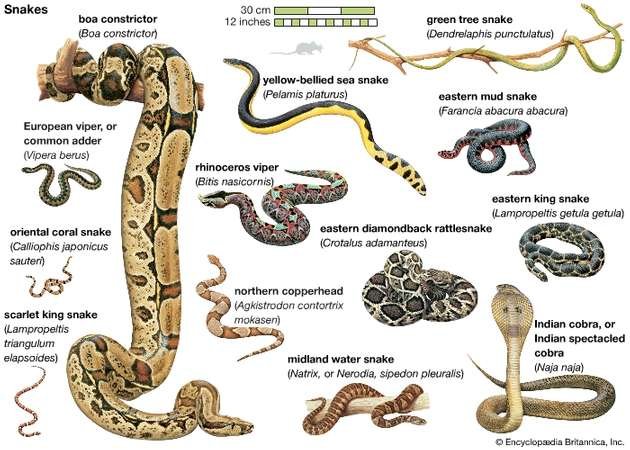
Venomous snakes have poison in their glands, serving as a defence mechanism and to kill prey, when this venom is injected by their fangs.
Other snakes are non-venomous, which means they are not poisonous; however, that doesn't mean that they don't have any defences. Just like venomous snakes, they have sharp fangs that they use to attack their prey or predators.
Examples of Venomous Snakes
One of the most common venomous snakes in America, is the rattlesnake. Although they are poisonous, their venom is not very strong.
American copperheads are another common venomous snake, found throughout North America. These are extremely dangerous because their venom is very powerful. There are different types of copperheads, including the southern copperhead, found in Texas.
One of the most venomous snakes is the eastern coral snake. While these reptiles have beautiful red, yellow, and black rings, their bite can be deadly to humans - so be on the lookout if you visit or live in the southern United States, or northern Mexico.
Examples of Non-Venomous Snakes
Snakes that are non-venomous, like the rhinoceros rat snake, must use innovative ways to kill their prey in order to survive.
Another example of a non-venomous snake, is the large python; which some people actually keep them as pets. The python attacks its prey and kills it using constriction, or by squeezing it. Pythons are strong and muscular, and most track the heat of their prey: birds, mammals, and other small reptiles.
As another example, the smallest type of non-venomous snake is called a thread snake. At less than four inches long, these snakes look more like worms. They are found throughout the world and like to burrow or dig underground, for termites and ants.
Special Abilities of Snakes
Some snakes can climb trees, swim, and even glide.
Snakes have scales covering their bodies, which are dry and smooth.
Corn snakes use their scales to shimmy up the sides of trees.
Other snakes, like water moccasins, like to swim in rivers and lakes.
The paradise tree snake has been known to flatten its body, catch a good breeze, and soar through the air!
Conclusion
For more on my series on amazing life in the water, on land & astoundingly parading the air, please follow me.
Thank You!
References:
https://en.wikipedia.org/wiki/Snake
https://www.britannica.com/animal/snake
https://en.wikipedia.org/wiki/Snake_venom
http://www.sciencekids.co.nz/sciencefacts/animals/snake.html
All images are linked to their sources.
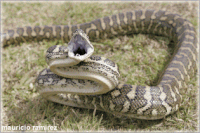



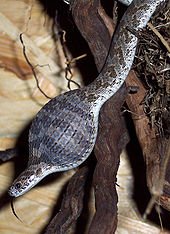


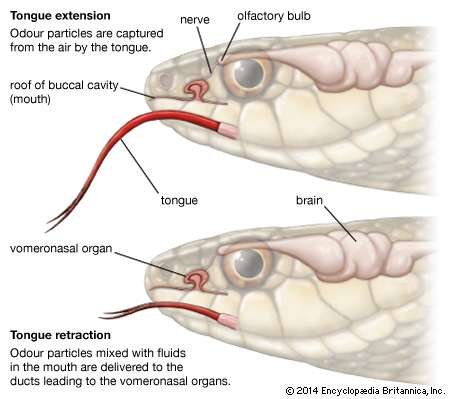




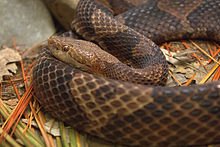
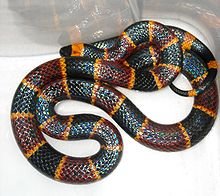

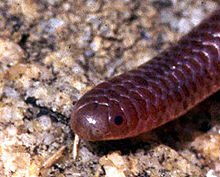


Being A SteemStem Member
Thank You @steemstem-bot!
The videos are just great and scary ...
Job well done
Thank You @godvesselt :)